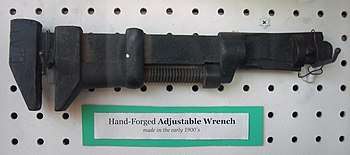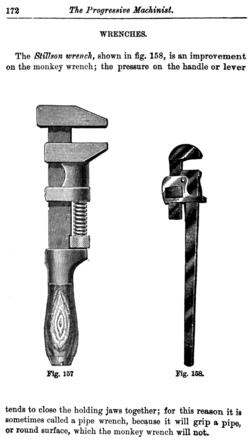Monkey wrench
The monkey wrench is a type of adjustable wrench, a 19th century American refinement of 18th-century English coach wrenches. It was widely used in the 19th and early 20th centuries but is now seldom used in the mechanical trades, having been mostly replaced by the newer style of shifting (adjustable) spanner/wrench. It is still of interest as an antique among tool collectors and is still occasionally used in maintenance and repair when it happens to be convenient. The term monkey wrench is also sometimes used loosely, usually by non-tradespeople, to refer to the pipe wrench (owing to their broadly similar shapes), but tradespeople (plumbers, pipefitters) usually speak more precisely than that. A wrench with smooth jaws (no teeth) is not used for turning threaded pipe.

These are also known as a Ford wrench owing to this type of wrench being included in the tool kit supplied with every Ford Model A. They are still used by aircraft technicians, mainly when large but low torque fasteners are involved.
Etymology and history

The World English Dictionary gives a nautical definition for monkey, as a modifier "denoting a small light structure or piece of equipment contrived to suit an immediate purpose: a monkey foresail ; a monkey bridge."[1]
Adjustable coach wrenches for the odd-sized nuts of wagon wheels were manufactured in England and exported to North America in the late 18th and early 19th centuries. They were set either by sliding a wedge, or later by twisting the handle, which turned a screw, narrowing or widening the jaws. In 1840, Worcester, Massachusetts knife manufacturer Loring Coes invented a screw-based coach wrench design in which the jaw width was set with a spinning ring fixed under the sliding lower jaw, above the handle. This was patented in 1841 and the tools were advertised and sold in the United States as monkey wrenches, a term which was already in use for the English handle-set coach wrenches.[2] For the next 87 years a very wide and popular range of monkey wrenches was manufactured by Coes family partnerships, licensees and companies, which filed further wrench patents throughout the 19th century. Some Coes wrenches could be bought with wooden knife handles, harking back to the company's early knife making business. In 1909 the Coes Wrench Company advertised a six-foot-long "key" wrench, shaped like a monkey wrench, for use on railroads.[3][4] The Coes wrench designs were acquired by longtime toolmaker Bemis & Call of Springfield, Massachusetts, in 1928. After 1939 its successor companies manufactured monkey wrenches from Coes designs until the mid-1960s, yielding a production run of over 120 years.[2][5][6]
Monkey wrenches are still manufactured and are used for some heavy tasks, but they have otherwise been mostly replaced by the shifting adjustable wrench/spanner, which is much lighter and has a smaller head, allowing it to fit more easily into tight spaces.
False etymologies
Charles Moncky myth
The following story can be found in sundry publications from the late 19th and early 20th centuries:
That handy tool, the "monkey-wrench", is not so named because it is a handy thing to monkey with, or for any kindred reason. "Monkey" is not its name at all, Charles Moncky, the inventor of it, sold his patent for $5000, and invested the money in a house in Williamsburg, Kings County, where he now lives.[7][8]
Although this story was refuted by historical and patent research in the late 19th century,[2] it appears to have been inspired by a real person. A Charles Monk (not Moncky) lived in the Williamsburg section of Brooklyn in the 1880s where he made and sold moulder's tools, not mechanics' tools like a monkey wrench.[9] He could not have invented or named the monkey wrench because he was born after the term first appeared in print.[9]
Racial slur hoax
A persistent hoax on social media claims boxer Jack Johnson invented the monkey wrench while in prison, but the wrench was named monkey wrench as a racial slur. The first patent for a monkey wrench was awarded before Johnson was born. Johnson did, however, receive a patent for improvements to it, but after it already had the monkey wrench name.[10]
See also
- Adjustable spanner/wrench
- Pipe wrench or Stillson wrench
- Plumber wrench
- The Monkey Wrench Gang
References and notes
- dictionary.reference.com, "monkey," Houghton Mifflin, 1997: World English Dictionary entry, 5th def.
- "The Boston Wrench Group (Imported English coach wrenches or 18th w19th century American copies?)". Davistown Museum. Retrieved 11 August 2008.
- ww.clarku.edu, Coes Wrench Co.
- Alloy Artifacts Archived 30 December 2011 at the Wayback Machine, "Coes Wrench Company," 2005-2011
- Alloy Artifacts Archived 30 December 2011 at the Wayback Machine, "Bemis & Call", 2005-2011
- "'The Monkey Wrench' mill building at 143 Main St. in Springfield, MA". Bemis & Call was acquired by a larger tool company in 1939. By the 2000s their old mill building on Main Street in the South End housed a commercial center known as "The Monkey Wrench."
- S.C. & L.M. Gould (1886). The Bizarre Notes and Queries in History, Folk-lore, Mathematics, Mysticism, Art, Science, Etc.
- William Rogers (1913) [1903]. "Part 1: The Progressive Machinist". Rogers Machinists Guide. Theo. Audel & Company, New York. p. 171.
moncky monkey-wrench rogers.
- Jensen-Brown, Peter. "Charles Monk, Monkey Wrenches and a Monkey on a Stick - a Gripping History and Etymology of "Monkey Wrench"". Early Sports 'n' Pop-Culture History Blog. Retrieved 3 April 2017.
- "Did Jack Johnson Invent the Monkey Wrench?". Snopes.com.
| Wikimedia Commons has media related to Monkey wrenches. |
| Look up monkey wrench in Wiktionary, the free dictionary. |